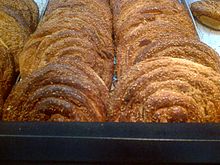A tahini roll or tahini bread roll is a sweet pastry found commonly in the cuisines of Arab countries, Armenia, Cyprus, Greece and Turkey. Tahini roll originated in Armenia, where they are called tahinov hatz.[1]
 | |
| Alternative names | Tahinopitta, Tahinli çörek |
|---|---|
| Type | Sweet roll |
| Place of origin | Armenia |
| Region or state | South Caucasus, Cyprus, Greece, Turkey, Levant |
| Main ingredients | Dough, tahini, sugar, cinnamon |
They are a popular street food in Cyprus.[2] In the Cypriot capital of Nicosia, street vendors with carts or bikes, as well as bakeries sell tahini rolls.[3]
Its name varies by location. In Arab countries it is known as khubz tahini.[4] The Armenian name is Թահինով Հաց. In the Greek language it is known as ταχινόπιττα (tahinopitta) or τασιηνόπιττα (tasinopitta); in Cypriot Greek the pronunciation is "tashinopita" with a "sh" sound as opposed to "h" in mainland Greek.[5] In the Turkish language, the general term is tahinli çörek, although in Cypriot Turkish it is known simply as tahınlı or tahınnı.[6]
The dough includes sugar and oil and has a texture between a bread and a cookie. It is leavened with yeast and can be baked after the first rise.[4] Sometimes the pastry may be soaked in syrup of sugar or honey, and flavored with cinnamon.[2]
Tahini rolls are made by rolling the dough flat, spreading it with the tahini mixture, sprinkling with sugar, and rolling into a log shape. The dough is then sliced into smaller pieces and flattened to form a circle.
See also edit
References edit
- ^ Brehaut, Laura (10 July 2020). "Cook this: Kubez el tahineh — sweet tahini rolls — from Falastin". National Post.
- ^ a b Waverman, Lucy (30 June 2015). "Recipe: Traditional Cypriot tahini pies". The Globe and Mail.
- ^ Çavuşoğlu, Mehmet; Çavuşoğlu, Olena (2018). "Gastronomi Turizmi ve Kıbrıs Sokak Lezzetleri Üzerine Bir Araştırma". Güncel Turizm Araştırmaları Dergisi. 2 (Ek 1): 644.
- ^ a b Perry, Charles (18 April 2007). "Tahini Cookies". Los Angeles times.
- ^ Drogari, Eleni. "Dancing the self: Cypriot sociocultural identity and contemporary choreography" (PDF). Roehampton University.
- ^ Kabataş, Orhan (2007). Kıbrıs Türkçesinin etimolojik sözlüğü. Kıbrıs Türk Yazarlar Birliği. p. 536.